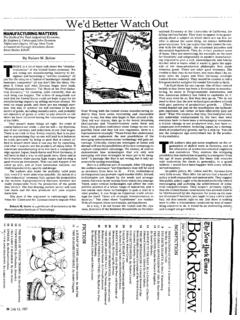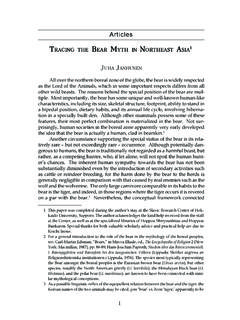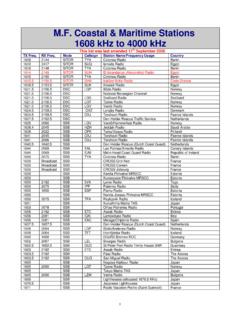Transcription of Paul%Krugman’s%“Thetheoryofinterstellartrade”,%formally ...
1 Paul Krugman s The theory of interstellar trade , formally published in Economic Inquiry 48: 1119- 1123 (2010). This document is a pre- print that should (except for the typesetting and the editor s note) match the published version. Posted by Yoram Bauman, Economic Inquiry co- editor for Miscellany, Jan 26 2011. Available at The Theory of interstellar TradePaul Krugman June 20, 2008 Editor s note:This article was written in July 1978 but has not been previ-ously published. With the exception of a few minor edits we are publishing it inits original form.
2 A PDF of the original typewritten manuscript can be found paper extends interplanetary trade theory to an interstellar is chiefly concerned with the following question: how should interestcharges on goods in transit be computed when the goods travelat close tothe speed of light? This is a problem because the time taken intransit willappear less to an observer travelling with the goods than to astationaryobserver. A solution is derived from economic theory, and two useless buttrue theorems are proved. Assistant Professor, Yale University. This research was supported by a grant from theCommittee to Re-Elect William IntroductionMany critics of conventional economics have argued, with considerable justifica-tion, that the assumptions underlying neoclassical theorybear little resemblanceto the world we know.
3 These critics have, however, been too quick to assert thatthis shows that mainstream economics can never be of any progressin the technology of space travel, as well as the prospects ofthe use of space forenergy production and colonization (O Neill 1976) make this assertion doubt-ful; for they raise the distinct possibility that we may eventually discover orconstruct a world to which orthodox economic theory applies. It is obvious,then, that economists have a special interest in understanding, and, indeed, inpromoting the development of an interstellar economy. One may even hope thatformulation of adequate theories of interstellar economicrelations will help ac-celerate the emergence of such relations.
4 Is it too much to suggest that currentwork might prove as influential in this development as the work of Adam Smithwas in the initial settlement of Massachusetts and Virginia?This paper represents one small step for an economist in the direction of atheory of interstellar trade. It goes directly to the problem of trade over stellardistances, leaving aside the analysis of trade within the Solar System. Inter-planetary trade, while of considerable empirical interest(Frankel 1975), raisesno major theoretical problems, since it can be treated in thesame framework asinterregional and international trade. Among the authors who have not pointedthis out are Ohlin (1933) and Samuelson (1947).
5 interstellar trade, by contrast,involves wholly novel considerations. The most important of these are the prob-2lem of evaluating capital costs on goods in transit when the time taken to shipthem depends on the observer s reference frame; and the proper modelling ofarbitrage in interstellar capital markets where or when (which comes to thesame thing) simultaneity ceases to have an unambiguous complications make the theory of interstellar trade appear at firstquite alien to our usual trade models; presumably it seems equally human toalien trade theorists. But the basic principles of maximization and opportunitycost will be seen to give clear answers to these questions.
6 I do not pretend todevelop here a theory which isuniversallyvalid, but it may at least have somegalactic remainder of this paper is, will be, or has been, depending on thereader s inertial frame, divided into three sections. Section 2 develops the basicEinsteinian framework of the analysis. In Section 3 this framework is usedto analyze interstellar trade in goods. Section 4 then considers the role ofinterstellar capital movements. It should be noted that, while the subject ofthis paper is silly, the analysis actually does make sense. This paper, then, is aserious analysis of a ridiculous subject, which is of coursethe opposite of whatis usual in Fundamental ConsiderationsThere are two major features distinguishing interstellar trade from the interplan-etary trade we are accustomed to.
7 The first is that the time spent in transit3will be very great, since travel must occur at less than lightspeed; round tripsof several hundred years appear likely. The second is that, if interstellar tradeis to be at all practical, the spaceships which conduct it must move at speedswhich are reasonable fractions of the speed of interstellar trade will take so long, any decision to launch a cargowill necessarily be a very long-term investment project, and would hardly beconceivable unless there are very extensive futures markets. I will assume, then,that future futures markets are, well, futuristic in their development.
8 In fact,I will assume that investors, human or otherwise, are able tomake perfectforecasts of prices over indefinite second feature of interstellar transactions cannot be so easily dealt with(physicists are not as tolerant as economists of the practice of assuming diffi-culties away). If trading space vessels move at high velocities, we can no longerhave an unambiguous measure of the time taken in transit. Thetime taken bythe spacecraft to make a round trip will appear less to an observer on the craftthan to one remaining on Earth. Since an interstellar voyageis an investmentproject which must have a positive present value, there is obviously a problemin deciding which transit time to use in the present value is an inertial problem which becomes a weighty problemin a gravi-tational field requiring an economic analysis, provided inthe next section.
9 Inthis section I develop the necessary physical concepts, illustrated in Figure trade between two planets, Earth and Trantor. I assume that the twoplanets may be regarded as being in thesame inertial frame. Then their world4lines in space-time can be represented by two parallel lines, shown atEE E andT T T in the figure. Several types of contact between the two planets arealso shown. The lineETis the world line of an electromagnetic signal say, arerun ofStar Trek sent from Earth to Trantor. If time is measured in yearsand space in light years,ETwill have a 45-degree slope. The lineE T is theworld line of a spaceship moving with uniform velocity from Earth to must be steeper thanET, because the spaceship s speed must be less thanthat of light.
10 Finally,E T shows a spaceship path which is more likely inpractice: it involves initial acceleration, followed by problem of time dilation must now be considered. It will suffice hereto consider the case of a spaceship with uniform velocity. Itis then well-knownthat, if the voyage from Earth to Trantor appears to takenyears to observers inthe Earth-Trantor inertial reference frame, it will appearto takenyears aboardthe spaceship, wheren=n 1 v2c2(1)wherevis the spacecraft s velocity andcthe speed of light. This can easilybe demonstrated by representing the voyage in Minkowski space-time, , witha real space axis and an imaginary time axis.








